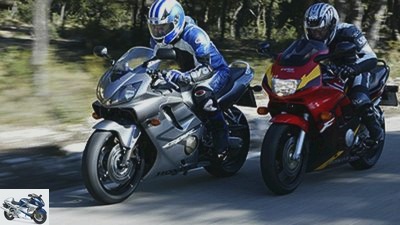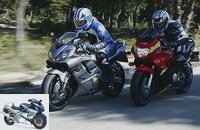Menus

Jahn
Generation comparison Honda CBR 600 F
Ten Years After
After years of arms race in the 600 class, Honda is shifting down a gear with the CBR 600 F. It costs little more today than it did ten years ago.
The price hit like a bomb: 8490 euros for a Honda CBR 600 F, model year 2005. Wow! The assembled high-end super athletes from Kawasaki to Yamaha and also Honda‘s 600 RR model are far more expensive themselves. You have to shell out a good 10,000 euros today if you don’t want to lose out in terms of engine power, uncompromising lightweight construction and sophisticated chassis technology.
But Honda has recognized that upgrading in the 600 class ends in a cost trap and that there is an urgent need for a sporty entry-level motorcycle that works at the push of a button. Just drive off and have fun. Hence this CBR 600 F, which is just as cheap as the one from 1995. Ten years ago, the buyer had to offer the equivalent of 8,176 euros. A first reason to compare the two. The second: a wonderfully preserved one C.BR 600 F of a colleague, built in 1995, 6000 kilometers run, first owner. Such a motorcycle that has not aged is ideal for experiencing ten years of development in fast motion.
Let’s look back to the time when
the CBR with the model code PC 31 beguiled the editors of MOTORRAD. The fourth generation started the 1995 season with lighter connecting rods and pistons, higher compression, larger cross-section carburettors and forced ventilation (ram air system). The gearbox, telescopic fork, brakes and fairing were modified, frames and triple clamps were stiffened and one at the rear five inch wide rim
assembled. At that time, the dynamometer transmitted 104.3 PS, which drove the MOTORRAD racing drivers into storms of enthusiasm. “At 5000 rpm, the CBR now picks up without grumbling, in order to add the first briquette at 8000 and two more at 10,000 rpm.”
Yes, the PC 31 was really strong and very fast at 150 mph. But with her “large portion of good-naturedness,” she said
Tester, many other qualities slumbered in it. Viewed from a tourist and everyday-oriented perspective, the slim 600 series impressed on every type of road and route, especially since, in addition to the carefree seating position for the driver, it even had a good level of pillion suitability. All in all, the CBR 600 F enjoyed the reputation of an egg-laying woolly milk sow.
Today, mid-March ?? it’s still pretty cold in Germany ?? it takes a while for the ten-year-old CBR to run smoothly and freely with the help of the choke. After a long cold run phase, however, the PC 31 appears to have been replaced. The four-cylinder turns upwards powerfully and silky, initially barking hoarsely. At 8000 / min the first kick, then at 10000 / min the next kick in the buttocks. There they are, the briquettes that were already inspiring in 1995. Now the engine is roaring its soul out of the body. The tachometer needle snaps past the 12000 mark. At 13200 rpm the limiter finally intervenes.
The 600, four-valve, four-cylinder has lost none of its fascination. The conglomerate of revving, background noise and performance boost still creates goosebumps. Plus a chassis that fits a normal person like a tailor-made suit. Comfortable, effortless, easy to use and control. The cold temperatures come in handy for the soft damper setting. When it gets warmer and faster, the rebound damping can at least be readjusted. And then the brakes. Even from today’s perspective, a stunner. In every situation, they tackle them in a dosed manner and courageously.
For the CBR 600 F, born in 2005, it is not easy to be better. Where-
wins with them just by looking at them. Her perky nose with the grim-
The moderate-looking double headlights are simply better than the ten-year-olds’ rather staid rectangular headlights. The progress of the engine is also epoch-making, recognizable at start-up and when running cold. A quick push of a button is all it takes, and thanks to the electronic injection, the four-cylinder runs smoothly. Permanent
Refinement and the shorter stroke of the newer CBR engine make a good 109 hp and an even higher level of revving possible. Exemplary exhaust gas cleaned with a three-way catalytic converter.
On the chassis side, the stiff, neatly welded aluminum bridge frame immediately catches the eye, which really makes the functional, but carelessly crumbled steel chassis of the old CBR look the same. Further equipment delicacies are the four-piston brake calipers and the stainless steel exhaust system. The new CBR 600 F simply offers more motorcycle for the same money.
The differences are less clear in driving practice. The four-cylinder barks an octave higher, it is even more supple and easy to turn. However, the hard load change is a bit annoying. The carburetor engine got down to business more smoothly. In any case, the development cannot be experienced in a new engine experience, but rather in the fact that the new one has retained the CBR character despite stricter exhaust and noise restrictions, and has even expanded its performance potential.
And the chassis seems to be a tad stiffer, which doesn’t detract from the handiness, but does help the accuracy. The coordination of the spring elements is tighter than with the PC 31, without any painful loss of comfort. So a successful compromise. In terms of braking effect and controllability alone, the four-piston fixed calipers do not make any significant difference to the floating calipers of the PC 31.But in the long run they ensure more constancy of the braking performance because the pads do not wear at an angle to the same extent as with the floating calipers, which are due to play Always twist a little bit on their guide pins when braking. There was simply nothing to improve in terms of seating comfort and ergonomics; there the new is completely the old. The current CBR also continues the honorable tradition of the screwdriver-friendly main stand as standard equipment.
The concept, which is more than ten years old, has been redesigned with modern technology at the old price, opens up a very attractive second way in the middle class. Affordable, uncomplicated driving fun instead of complex racing technology for specialists.
Buy complete article

Generation comparison Honda CBR 600 F
Ten Years After
Technical data: HONDA CBR 600 F (1995)
engine
Water-cooled four-cylinder four-stroke Rei-
engine, two overhead, chain-driven camshafts, four valves per cylinder, bucket tappets, wet sump lubrication, constant pressure carburetor, Ø 36 mm, no exhaust gas cleaning, alternator 340 W, battery 12 V / 8 Ah, mechanically operated multi-disc oil bath clutch, six-speed gearbox, O-ring Chain.
Bore x stroke 65.0 x 45.2 mm
Cubic capacity 600 cm3
Compression ratio 12.0: 1
rated capacity
72 kW (98 PS) at 12,000 rpm
Max. Torque 63 Nm at 10500 rpm
landing gear
Bridge frame made of steel, load-bearing engine, telescopic fork, Ø 41 mm, adjustable spring base and rebound damping, two-arm swing arm made of steel, central spring strut with lever system, adjustable spring base, rebound and compression damping, double disc brake at the front, Ø 296 mm, double-piston floating calipers, disc brake at the rear, Ø 220 mm, single-piston floating caliper.
Cast aluminum wheels 3.50 x 17; 5.00 x 17
Tires 120/60 ZR 17; 160/60 ZR 17
mass and weight
Wheelbase 1405 mm, steering head angle 64.9 degrees, caster 94 mm, suspension travel f / h 130/110 mm, seat height * 800 mm, weight with a full tank * 210 kg, payload * 187 kg, tank capacity 17 liters.
Two year guarantee
Service intervals every 6000 km
Price without additional costs (1995)
15990 marks (8,179 euros)
Technical data: HONDA CBR 600 F (2005)
engine
Water-cooled four-cylinder four-stroke in-line engine, two overhead, chain-driven camshafts, four valves per cylinder, bucket tappets, wet sump lubrication, injection, Ø 38 mm, regulated Kata-
lysator with secondary air system, alternator 408 W, battery 12 V / 9 Ah, mechanically operated multi-disc oil bath clutch, six-speed gearbox, O-ring chain.
Bore x stroke 67.0 x 42.5 mm
Displacement 599 cm3
Compression ratio 12.0: 1
rated capacity
80 kW (109 PS) at 12,500 rpm
Max. Torque 65 Nm at 10 500 rpm
landing gear
Bridge frame made of aluminum, load-bearing motor, telescopic fork, Ø 43 mm, two-arm swing arm made of aluminum, central spring strut with lever system, adjustable feet-
derbasis, double disc brake at the front, Ø 296 mm, four-piston fixed calipers, disc brake at the rear, Ø 220 mm, single-piston floating caliper.
Cast aluminum wheels 3.50 x 17; 5.50 x 17
Tires 120/70 ZR 17; 180/55 ZR 17
mass and weight
Wheelbase 1395 mm, steering head angle 66 degrees, caster 96 mm, spring travel f / r 120/120 mm, seat height * 810 mm, weight with a full tank * 201 kg, load * 186 kg, tank capacity 18 liters.
Two year guarantee
Service intervals every 6000 km
Price excluding additional costs 8490 euros
Related articles
-
Comparison test BMW K 1200 GT, Honda Pan European, Yamaha FJR 1300 A
Gargolov comparison test BMW K 1200 GT, Honda Pan European, Yamaha FJR 1300 A Flying Dutchmen The opportunity has never been better: three express tourers …
-
Comparison test between the Honda XR 125 L and the MZ 125 SX
Jahn comparison test Honda XR 125 L against MZ 125 SX New times Cheap Honda against expensive MZ, ancient engine from Japan against high-tech four-valve …
-
Gargolov comparison test big bikes: Honda CBR 1100 XX Super Blackbird, Kawasaki Ninja ZX-12R, Suzuki GSX 1300 R Hayabusa, Yamaha FJR 1300 A Two fast, Two …
-
Comparison test Honda CB 1300 S, Suzuki Bandit 1200 S, Yamaha FZ1 Fazer
Bilski comparison test Honda CB 1300 S, Suzuki Bandit 1200 S, Yamaha FZ1 Fazer search for traces They have sporty roots in common. At the Honda in …
-
Comparison test of 400 enduro bikes: Honda XR 400 R, KTM LC4-E 400, Suzuki DR-Z 400 S
Comparative test of 400 enduro bikes: Honda XR 400 R, KTM LC4-E 400, Suzuki DR-Z 400 S through the middle Loosely over hill and dale ?? Honda XR 400 R, KTM LC4-E …
-
Comparison between the Honda XLV 750 R and the Varadero 1000
Rossen Gargolov comparison Honda XLV 750 R against Varadero 1000 late bloomer 220 kilograms heavy, massive as a tank ?? the XLV 750 R spun in 1983 …
-
Comparison test Honda Hornet 600 ABS, Kawasaki Z 750 ABS and Triumph Street Triple
Artist comparison test Honda Hornet 600 ABS, Kawasaki Z 750 ABS and Triumph Street Triple Weekend Warriors Life is almost sterile. Engines…
-
Comparison test: Honda CBR 600 RR, Triumph Daytona 600
Gargolov comparison test: Honda CBR 600 RR, Triumph Daytona 600 Greedy looks The new Daytona 600 looks aggressive and greedy. Hungry …
-
Generation comparison Suzuki 1200-1250 Bandit
Generation comparison Suzuki 1200/1250 Bandit Glorious bandits Suzuki’s extremely successful large Bandit models are the prelude to a new …
-
Cruiser comparison test: Honda VTX 1300 S, Kawasaki VN 1600 Classic
Cruiser comparison test: Honda VTX 1300 S, Kawasaki VN 1600 Classic Damn long and heavy Handy six-centimeter chunks, wheelbases begging for parking bay, …